by pmdavis | Jan 5, 2015
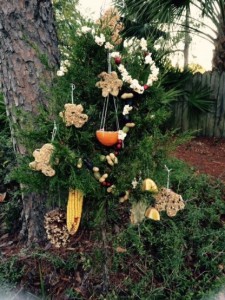
While youth are home over winter break, encourage them to do something fun that will attract wildlife. Nothing is more fun than watching birds or squirrels play in your yard. One way to make this happen is to provide a supplemental food source for them. You can create a special “Tree for Wildlife” in your yard. In fact, a great family activity is making some very inexpensive simple feeders. The most wonderful part is these feeders, they not only look attractive, but help wildlife survive through the winter.
You can create feeders out of bread, bird seed and a binding agent like eggs, lard or peanut butter. Cut stale bread into shapes with cookie cutters. Make a small hole in the top to put twine or string through. If using egg, brush the bread with egg wash and dip in seeds. Then let it dry for a day or so. Attach string and hang in the trees. If using lard or peanut butter, toast the bread to dry it out then spread like you would on a sandwich and roll in bird seed.
Another type of feeder that is popular especially if you have lots of pine trees are pine cone bird feeders. Attach string to a pine cone. Mix peanut butter and oats together then apply to pine cone. After the cone is covered with the mixture roll in bird seed. Lard can be used in place of peanut butter. Hang from tree.
One last type of feeder is using apple and orange slices. Cut thin slices of apples and oranges, attach string and hang each slice separately all around the tree.
Additional feeders could be strings of grapes, raisins, cranberries, raw peanuts, salt free crackers or popcorn. If you are using popcorn be sure it does not have butter and salt. Just use a needle and thread to make the strings. All edible decorations should be hung with biodegradable materials such as cotton string, twine, or thread.
For more information to help you invite wildlife into your yard check out Junior Master Gardener: Wildlife Gardener or Cornell Feeder Watch. Inviting wildlife into your yard provides a fun way for kids to develop a culture to care about nature, while teaching them about their environment. It also makes a great family traditional activity to do not only during the holiday season but throughout the year. 4-H is one of the nation’s most diverse organizations and includes people from all economic, racial, social, political, and geographic categories. There are no barriers to participation by any young person. Participants are given the opportunity to engage in activities that hold their personal interest, while being guided by adult volunteers. The local 4-H Agent is a youth development professional who provides direction and program leadership as part of the nationwide Cooperative Extension System. For more information, contact UF/IFAS Extension at http://florida4h.org/
.
by Heather Kent | Oct 31, 2014
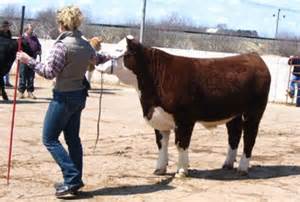 For 4-H members and spectators alike, livestock shows are one of the most anticipated parts of a fair. Preparing your animal for a show begins months in advance. Great care is needed in feeding your animal, practicing showmanship, and making sure your animal is healthy. After all the time and effort that goes into raising your animal, you want to make sure that you have everything you need once you arrive at the fairgrounds.
For 4-H members and spectators alike, livestock shows are one of the most anticipated parts of a fair. Preparing your animal for a show begins months in advance. Great care is needed in feeding your animal, practicing showmanship, and making sure your animal is healthy. After all the time and effort that goes into raising your animal, you want to make sure that you have everything you need once you arrive at the fairgrounds.
Angel Granger, the 4-H Agent in Jackson County (also a former livestock club leader and 4-Her) suggests investing in a show box or rubber tote to keep all of your show supplies together.
Packing List for Large Animal Shows:
- Grooming tools- scotch comb, brush, shampoo, blower, clippers, scissors
- Feed supplies- feed, hay, buckets, feed tubs (rubber tubs work well)
- General supplies- water hose, spray nozzle, rubber boots, extension cord, extra rope, pitch fork, square point shovel, rake, and wheel barrow. Depending on the time of year, a fan is also a good idea (the temperature tends to change quickly in the fall and spring and can be unpredictable). Also pack a sign or poster about your animal (breed, age, name, sponsor, etc).
- General animal first-aid kit. Antibiotic cream/salve, aspirin boluses and balling gun, blood stop powder, and bleach. It is a good idea to disinfect the sand before you place your animal on the ring. A simple bleach mixture of 1 part bleach to 4 parts water, in a spray bottle will do.
- Show equipment. Show stick, show halter/lead, tie out halter and lead ropes.
Packing List for Small Animal Shows:
- Grooming tools (brush, comb, nail file, nail clippers, grooming apron or old clothes)
- Feed supplies- feed, feed containers, water bottle
- General supplies- bucket, rags, string or tie wire, sign for your animal (name, breed, age, sponsor, etc)
- General animal first aid kit.
- Show equipment- most dog shows require a leash.
Supplies needed for every show regardless of the species you are showing:
- Show clothes. There is no uniform for 4-H, but you will want to dress neatly and modestly. A button down shirt and dark pants are appropriate. A neck tie or 4-H bolero tie is a nice touch. Make sure your hair is neatly styled and pulled back away from your face. You may also want to bring some safety pins for your exhibitor tag.
- Human first aid kit- you can purchase one for less than $10.00, or put one together yourself (band aids, antibiotic ointment, pain reliever).
- Paperwork: A copy of the registration form you mailed/submitted, your animal’s health papers, your lease document (if applicable), and your ORIGINAL breed registry papers. Photocopies will not be accepted at check-in. It is a great idea to put these papers in a three-ring binder inside sheet protectors.
- Your knowledge and good sportsmanship! Be familiar with your animal so that you are prepared to answer any questions the judge may ask. Look over your feed record and record book. Remember to both win and lose gracefully.
Be sure to label your items with your name. Consider laminating your packing list and keeping it in your show box with a dry-erase marker. That way, you can check the items off as you load them into your box or trailer. Being prepared will help you be less nervous and make your experience much more enjoyable. See you at the fair!
by Heather Kent | Oct 9, 2014
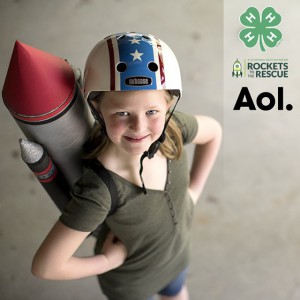 4-H National Youth Science Day (NYSD) is a great opportunity to engage youth in 4-H Science. Each year, National 4-H Council announces a National 4-H Science Experiment. NYSD is October 8th, but the experiment can be conducted anytime. This year, youth will be tasked with the same mission: in light of the recent natural disasters such as Typhoon Haiyan, National 4-H Council is asking youth to design and build an aerodynamic food transportation device that can deliver a payload of nutritious food to disaster victims. Youth will learn engineering concepts, develop math skills, learn about nutrition and help solve a relevant, global issue.
4-H National Youth Science Day (NYSD) is a great opportunity to engage youth in 4-H Science. Each year, National 4-H Council announces a National 4-H Science Experiment. NYSD is October 8th, but the experiment can be conducted anytime. This year, youth will be tasked with the same mission: in light of the recent natural disasters such as Typhoon Haiyan, National 4-H Council is asking youth to design and build an aerodynamic food transportation device that can deliver a payload of nutritious food to disaster victims. Youth will learn engineering concepts, develop math skills, learn about nutrition and help solve a relevant, global issue.
You can purchase a pre-made experiment kit from the 4-H Mall, or you can make your own for less than $10.00. All of the supplies can be found at your local hardware or big box store. A “how-to” video shows you how to set up and facilitate the experiment. A word of caution- the video shows youth jumping onto the launcher with both feet- this weakens your launcher and could cause youth to lose their balance. We recommend that youth only stomp on the bottle with one foot.
Experiment guides for volunteers and youth can be found online for free. If you register your event online, you will get access to three more activities that you can do with your kit. For teachers who lead in-school or afterschool 4-H clubs, this experiment achieves many of the common core science standards There are several contests and prizes for clubs, teachers, and youth. Many of these contests offer cash prizes or gift cards. To find out more, visit the NYSD website.
We would love to know how you and your youth benefited from this program. Please complete the evaluation for volunteers, and share the link for the evaluation for youth with your club members.
How do you plan on celebrating NYSD this year? Share your photos and ideas on our District Facebook and Twitter! Also, make plans to join us on October 20th for Make a Difference Monday at 7/6 central. Dr. Dale Pracht will be sharing how to create safe environments in our 4-H clubs. If you cannot make our live presentation, it will be archived along with this month’s presentation at http://florida4h.org/madmondays.
by Melanie Taylor | Jul 9, 2014
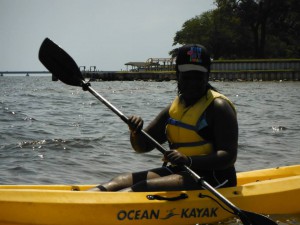
4-Hers still enjoy swimming and kayaking in the Choctawhatchee Bay. Photo provided by Jackson County 4-H.
Summer is here, and for most 4-H families, that means camp is on the horizon. If this will be your child’s first summer camp experience, you and your child both may have some camp anxieties. But never fear! Here are some simple steps you can take to prepare your camper (and yourself) for camp:
Preparing Campers:
• Plan several sleep overs before the week of camp arrives. Resist the urge to pack their bags for them or to check on them while there. If they have a cell phone, have them leave it at home. This is a good way to practice not having direct or constant contact.
• Encourage them to write a letter to someone (maybe you) while at camp. You will be so excited when you receive a letter from camp! Be sure to include envelopes, addresses, stamps, paper, and a pen in their luggage.
• Gear up physically. If you have purchased new tennis shoes, break them in with a few long walks, so the blisters don’t have to happen at camp.
• Especially for teenagers, have them take a mini-vacation from their electronic devices. A couple of hours or a weekend.
• Have them write a statement for their social media pages. “Peace out Facebook, I will be at camp for the next week. Check in with you when I get back.” Or something similar.
• Have them write down their goals for camp. So they can mentally prepare themselves for what they hope to do and see.
• Make a homesick plan:
1. Homesickness isn’t entirely bad. It’s great to love your home. It’s sometimes part of the process, and it’s a confidence booster when a camper gets through it.
2. Make a happy place plan and write it down. This is an amazing opportunity to learn a life skill. Today’s youth go to technology to escape, and studies show this increases their stress. Some ideas might be: taking 10 deep breaths, traveling to a happy place in your mind, packing a certain stuffed animal, or tossing a football. They are capable of this independence.
3. Your plan should NOT be, “Give it a couple of days and if you don’t like it, we will come get you.” This will set them up to give it a couple of days and knock the confidence right out of them.
4. Let your camper know what to expect with correspondence. You don’t need to write every day, but let them know what to expect.
Parents:
• You are giving your child an incredible gift. I cannot promise you that they will not lose some socks, that they will love every meal or activity, or that they will adore every counselor. But you are preparing them for college and beyond; you are giving them the freedom to gain confidence, independence, and leadership skills; and you are instilling in them that they can do it.
• What do YOU want to do during their time at camp? Plan a vacation for a later time, time to organize, time to have one-on-one time with your other children, or some “date nights” with your spouse or friends.
• If you have apprehensions, work to resolve them. If you are worried that your camper is not going to know anyone, set up a pre-camp get-together. If you are worried about your camper’s medical needs, become friendly with the camp staff. If you are anxious about their food allergies, talk to the camp’s director. Make a camper-sick plan for yourself. Make sure there is only excitement and optimism coming from you, and share your anxiety with another adult.
• Pack self-addressed envelopes in their luggage.
• Whether they are flying or driving, refrain from crying your eyes out until they cannot see you. Take a deep breath, trust, and remind yourself that you are giving them an awesome gift.
And, what is this gift everyone is talking about? At camp, they will be part of a community all their own. They will become emotionally attached to handmade rope bracelets on their wrist, and have a song for any occasion on cue, and maybe even forget they need to shower, and think sunscreen is just a normal daily moisturizing technique. They will learn to do things on their own, and they’ll learn to rely on others. They will learn how to survive on their own for a week or two, and they’ll learn how to help each other through it.
They may even grow up on summers away from TV, and forget Facebook exists. They will relish in the joy of sleeping in cabins, swatting mosquitoes at campfire, and swimming every day. They will savor the feeling of pushing water behind them with a paddle and the whoosh of air behind the tail of an arrow as they fire. They’ll forget about appearances, relish tan lines, and recognize the beauty of a smile over anything else.
So send your kids to camp. Send them so they’ll learn to set tables and make beds and wake early. Send them so they’ll know how to be a leader, paddle a kayak, weave a bracelet, and sing as loud as they can. Send your kids to camp so they’ll learn to love themselves and learn to love others. Send your kids to camp because they’ll realize who they are, or who they want to be. And, prepare yourselves for a year of camp stories, and for a flurry of songs. Prepare to learn names of kids you’ve never met. And for your kids to have a need for sunshine, a need for campfires, and companionship. They will be forever grateful for your awesome gift of summer camp.
Source:
American Camping Association, Inc. (http://www.acacamps.org)
by Marcus Boston Jr. | Mar 10, 2014
Embryology is defined as science that deals with the study and development of an embryo. In this project, participants will learn how life develops by observing chicken eggs that you will set in your incubator. The 4-H club leader(s) as well as the youth will be responsible for the daily care of the incubator and eggs throughout the process.
Children have a natural sense of curiosity about living things in the world around them. Building on this curiosity, students can develop an understanding of biology concepts through direct experience with living things, their life cycles and their habitats. 4-H has always promoted “hands on” activities through its many project areas, most specifically embryology. This project allows its participants to learn by listening, observing, experimenting and applying their knowledge to real-world situations.
How Do You Get Started? If I attempted to list all the steps involved in the 4-H Embryology Project I would eventually run out of room in this posting. The recommended step to take in getting this project off the ground is to contact and partner with your 4-H extension agent. They may be able to help you get started by securing an incubator, identifying a reliable source for fertile eggs, and provide additional resources in the form of “project and/or record books” for the youth participating in the project. The agent will also be able assist with planning your calendar, establishing a location for the hatched chicks and to troubleshoot just in case problems arise throughout the project. There are many different types of incubators that can be used to hatch eggs but working with your 4-H professional to make sure you have the right one for your project is essential to having a successful hatch.
What If I’ve Done This Project Before? If you are already familiar with how to set up your embryology project it is still recommended to inform your 4-H extension agent so they can keep an accurate record of the number of youth engaged in the embryology project while at the same time provide the support and additional assistance that may be needed.
So What’s Next? Decide along with your club members where the incubator will be kept, follow your 4-H Embryology Project Book Curriculum and watch in amazement as the youth in your club develop their curiosity, increase the communication with each other, and deepen their understanding of science, engineering and technology while taking a journey through an unforgettable experience.
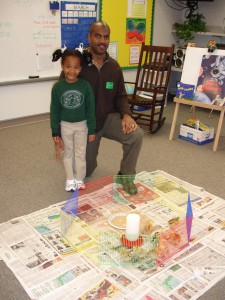
4-H Agent Marcus Boston completing 4-H Embryology with kindergarten class
by jgl1 | Nov 8, 2013
John G. Lilly
jgl@ufl.edu
Jefferson County Extension Director/4-H Agent
Young people in 4-H are committed to improving their communities. Dr. Richard Lerner, and the team at the Institute for Applied Research in Youth Development at Tufts University highlights a notable trend. 4-H youth are three times more likely to actively contribute to their communities when compared with youth who do not participate in 4-H. (more…)





